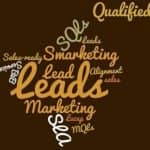
It’s acceptable for every company to have it’s own definition of exactly what is a sales qualified lead (SQL) for them. In order to understand this, we also have to look at what is a marketing qualified lead (MQL), and how to get your marketing and sales departments to agree on aligning both definitions.
What is smarketing?
You need to make the transition of the lead from marketing to sales smooth and seamless for the buyer. This alignment, better known as smarketing, can only happen when both teams sign on to service-level agreements (SLAs) with each other that lay down clear definitions for things such as quality and number of leads, and timelines on which the leads have to be acted upon.
In case you’re wondering why smarketing is important, the slide below says it all.
Sales And Marketing Alignment: The Good, The Bad, and The Ugly from Altify
Leads from your website, referrals, email marketing, social media, ad campaigns and other sources all need to be mopped up and fed into a CRM, and then the lead management process takes over. You have to take the lead forward in the buying cycle to a point where the lead can be labeled as sales-ready.
What is a sales ready lead?
The tipping point where a lead can be called a sales ready lead is where the lead begins to show an interest in or readiness to buy your product or service. This may be decided based on multiple factors (repeat website visitors, downloads, etc.) that all carry weightage in the lead scoring system.
This whole discussion boils down to two things:
Can you get Marketing and Sales to agree on what is a sales ready lead, and when it can be passed onto sales from this point of view of the degree of qualification needed before the sales team finds leads converting into sales?
Can you get Marketing and Sales to agree on a time period within which Sales needs to start chasing down a lead that Marketing has handed over to them?p>
If you can get both departments to sign on to SLAs that lay down clear answers for both these questions, it entirely eliminates the constant bickering over why a lead didn’t pan out. Sales can’t say that Marketing is handing them unqualified leads that are not potential or interested buyers, and Marketing can’t blame the lack of conversions on lead response delays by Sales.
How to Calculate Your Marketing SLA
SLA goals for the marketing side’s commitment include the number of marketing generated leads, how many customers this should convert into, and the total marketing-sourced revenue generated. In order to calculate these things, you need some data from your CRM and Google Analytics or whatever other analytics tool you are using. The data needed is (source – Hubspot):
Total sales goals in terms of revenue quota;
% revenue that comes from marketing-sourced leads;
Average sales deal size; and
Average lead to customer close %
So you can get Marketing’s revenue goal by multiplying the first two in the above list (sales quota and % revenue from marketing-sourced leads). Input this revenue goal, along with average deal size and your conversion rate, into any online traffic-leads calculator to get the number of conversions and leads required from Marketing. Now you have your Marketing SLA.
How to Set Sales SLAs
The Sales SLA is a commitment about the speed with which marketing-sourced leads will be responded to, and the minimum number of follow-ups that Sales will provide for each lead. Lucep data shows the importance of instant response to sales leads, with more than half of all leads giving their business to the company that responds first.
As for follow-ups, Hubspot data shows that a full 44% of sales reps give up after one follow-up, but 80% of sales happen only after five followups. So 6-9 follow-ups are recommended within a set period in order to ensure that you maximize your chances of a conversion happening before the lead goes into a nurture track.